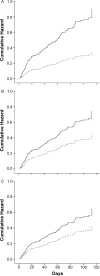A Refined Prediction Model for Core and Lower Extremity Sprains and Strains Among Collegiate Football Players
- PMID: 25844856
- PMCID: PMC4527449
- DOI: 10.4085/1062-6050-50.2.04
A Refined Prediction Model for Core and Lower Extremity Sprains and Strains Among Collegiate Football Players
Abstract
Context: Researchers have identified high exposure to game conditions, low back dysfunction, and poor endurance of the core musculature as strong predictors for the occurrence of sprains and strains among collegiate football players.
Objective: To refine a previously developed injury-prediction model through analysis of 3 consecutive seasons of data.
Design: Cohort study.
Setting: National Collegiate Athletic Association Division I Football Championship Subdivision football program.
Patients or other participants: For 3 consecutive years, all 152 team members (age = 19.7 ± 1.5 years, height = 1.84 ± 0.08 m, mass = 101.08 ± 19.28 kg) presented for a mandatory physical examination on the day before initiation of preseason practice sessions.
Main outcome measure(s): Associations between preseason measurements and the subsequent occurrence of a core or lower extremity sprain or strain were established for 256 player-seasons of data. We used receiver operating characteristic analysis to identify optimal cut points for dichotomous categorizations of cases as high risk or low risk. Both logistic regression and Cox regression analyses were used to identify a multivariable injury-prediction model with optimal discriminatory power.
Results: Exceptionally good discrimination between injured and uninjured cases was found for a 3-factor prediction model that included equal to or greater than 1 game as a starter, Oswestry Disability Index score equal to or greater than 4, and poor wall-sit-hold performance. The existence of at least 2 of the 3 risk factors demonstrated 56% sensitivity, 80% specificity, an odds ratio of 5.28 (90% confidence interval = 3.31, 8.44), and a hazard ratio of 2.97 (90% confidence interval = 2.14, 4.12).
Conclusions: High exposure to game conditions was the dominant injury risk factor for collegiate football players, but a surprisingly mild degree of low back dysfunction and poor core-muscle endurance appeared to be important modifiable risk factors that should be identified and addressed before participation.
Keywords: clinical decision making; low back pain; primary injury prevention.
Figures





References
-
- van Mechelen W, Hlobil H, Kemper HC. Incidence, severity, aetiology, and prevention of sports injuries: a review of concepts. Sports Med. 1992;14(2):82–99. - PubMed
-
- Finch C. A new framework for research leading to sports injury prevention. J Sci Med Sport. 2006;9((1–2)):3–9. - PubMed
-
- Meeuwisse WH. Assessing causation in sport injury: a multifactorial model. Clin J Sport Med. 1994;4(3):166–170.
-
- Van Tiggelen D, Wickes S, Stevens V, Roosen P, Witvrouw E. Effective prevention of sports injuries: a model integrating efficacy, efficiency, compliance and risk-taking behavior. Br J Sports Med. 2008;42(8):648–652. - PubMed
MeSH terms
LinkOut - more resources
Full Text Sources
Other Literature Sources
Medical

